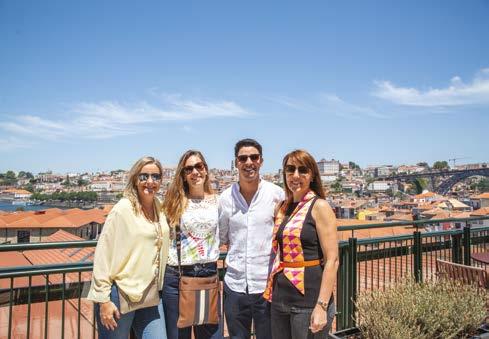Thank you.
Brokerslink would like to thank all sponsors for contributing to the success of the Brokerslink Conference 2022.
2022 Programme at a Glance
Thursday, 26th May
Welcome remarks & Brokerslink in review
José Manuel Fonseca Brokerslink Chairman
Network expansion 2020-2022
Moderator: Carla Alves Brokerslink
David Pryce, Fenchurch Law, UK
Duane Lohn, B. Riley, USA Marcel Chad, Piiq, UK Rodney Farah, PRFC, Trinidad & Tobago
Brokerslink good collaboration, great success!
Moderator: Anne Collette Brokerslink Maurizio Castelli Augustas, Italy
Carlos Pineda CyR, El Salvador Ariel Couto MDS, Brazil
Space B user experience

Moderator: Anne Collette Brokerslink Pedro Moura Ferreira MDS, Portugal
Hélène Paounov, Filhet-Allard, France Filip Frans Van Dessel, Belgium David Horne Bridge, UK
B.tech – an added Brokerslink value Anne Collette, Brokerslink Kilian Collins, Brokerslink
Understanding and leveraging your DE&I ecosystem for greater impact
Moderator: Miguel Miranda, Regional Underwritting Manager A&H Europe, Middle East and Africa - AIG Benedetta Cossarini, General Manager Iberia, AIG Gonçalo de Salis Amaral Partner-Head of HR Consulting, Neves de Almeida
Marjorye Hoejenbos Reinsurance Director, MDS, Brazil
Rohan Stewart, Group Manager People & Innovation, PSC Insurance Group
Closing remarks
Pedro Sacadura Conference MC
Networking Dinner
Friday, 27th May
Welcome to Porto Rui Moreira , City Mayor
Welcome remarks
José Manuel Fonseca, Brokerslink Chairman Anthony Lim, Brokerslink Board Director
Partnering for progress
Andreas Berger CEO, Swiss Re Corporate Solutions
The emerging risks and opportunities in the aviation industry
Marcel Chad, President, Piiq Risk Partners
Mark Hue Williams Senior Partner, Piiq Risk Partners
Seven grand effects of great powers competition
Bernardo Pires de Lima Foreign Affairs Analyst
Moderator: Pedro Sacadura Conference MC Bernardo Pires de Lima Foreign Affairs Analyst
Duncan Strachan, Partner in the Global Insurance Group, DAC Beachcroft
Grant English, PV & Terrorism Underwriter, Geo Underwriting
Risk management @ Nestlé
Laurent Freixe Executive Vice President & CEO Latin America, Nestlé
Technology trends reshape insurance business models - Embedded insurance and AI-supported underwriting are on the rise
Martin Thormählen CTO, Munich Re
Profitable caring
Steven Braekeveldt CEO, Ageas Group Portugal
Risk Managers panel
Moderator: Jorge Luzzi President and Executive Director, APOGERIS
Alicia Soler Executive Director, AGERS
Jorge Neto, Risk and Insurance Manager, Jerónimo Martins
Raphael Tasseli Risk Manager, Suzano
The Power of geography in global politics
Tim Marshall Journalist, author and broadcaster
Closing remarks
José Manuel Fonseca, Brokerslink Chairman
Conference 2023 announcement
Gala Dinner
The world, it seems, has been in a state of constant flux for the last few years. Everything, from Brexit and the pandemic to war in Ukraine and rampant inflation, has conspired to force societies and economies to rethink how they function.
And it has led Brokerslink to rethink itself too, as José Manuel Fonseca, Brokerslink Chairman, explained to delegates as he opened the 2022 conference in Porto.
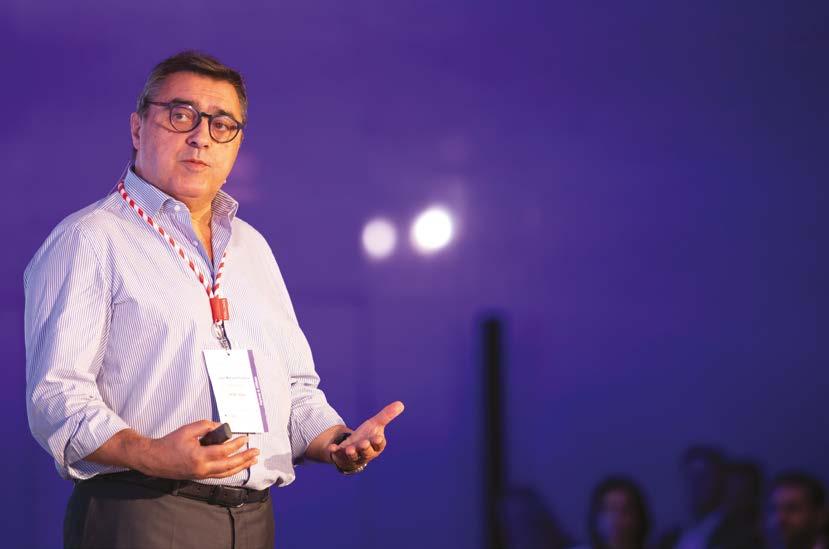
“Our first global conference was in Hong Kong in 2009 but since then, we have been continually growing and in the last two years alone, during Covid, we have welcomed 23 new retail broker affiliates, six specialist firms and seven insurtechs to the network.”
Every year since its birth in 2004 has seen the network grow with new affiliates from new territories joining all the time. But as affiliation has grown over the years, the structure of the network has had to evolve to support the growth.
“Our first years were dedicated to establishing an idea that we could create a different kind of network, one that was built upon the concept of partnership. We established those first partnerships in Asia, then Latin America and built the global footprint we have today from there,” said José.
He explained that phase two (2009-15) was about expanding the company, establishing new strategic partnerships with brokers and consulting firms and by 2013, the network had a presence in 85 countries all working towards the vision of developing a complete risk solutions company.
“The following phase began in 2015 when we incorporated Brokerslink in Switzerland, bringing 60 shareholders and investors to help the company jump to the next stage,” said José.
“This new chapter is much more business oriented, more dedicated to leveraging all our infrastructure and facilitating greater interaction between all the partners and affiliates. It is about leveraging the true potential of the network and building an operating model that will support that.”
He said that it is not just the network that has to rethink itself but individual partners and affiliates too.
“Our role in distribution is changing fast and we have to adapt to that which is why we have established a structural project to rethink the company and design a new face for the future. You can all still contribute to this as we need everyone to rethink themselves,” he said.
And with 360 attendees from 71 countries, representing six continents at the conference, José was able to say with confidence: “We truly embrace the world, from Japan to Mexico, and we are a force, but we must stay true to our original principles – human relationship, independence, no rivalry between partners and affiliates and, above all, collaboration.”
The world today
Insurance exists to protect individuals and businesses from the financial fallout of risk. The fact that the industry is still going strong more than 300 years after Edward Lloyd established the modern model of insurance, is testament to its ability to deliver.
Much has changed in that time and while insurance has largely kept pace with that change, such is the political, social and economic volatility in the world today, that those of us who make up the insurance sector, have to rethink how we deliver the security clients crave, how we serve their needs in new ways, and most importantly, how we evolve our products and services to meet changing demands.
This message came through loud and clear in sessions at Brokerslink Conference 2022. For example, Andreas Berger, CEO, Swiss Re Corporate Solutions, argued that some of the results posted by insurers this year suggest that they haven’t yet factored in the impacts of climate change, inflation, geopolitical uncertainty and war.
“We are still digesting what inflation really means but we have more coming with the war in Ukraine and while inflation was predicted to be short term, it is happening everywhere now,” he said.
When it comes to hot topics for businesses around the world, the phrase on everyone’s lips is supply chain problems but according to Andreas, corporates are looking to the insurance industry to help them manage these issues. Less and less are they looking for financial compensation and increasingly they are looking for business resilience.
“It is always about being transparent with the customer and resilience and responsibility will be at the heart of what corporates want and those that can address this will win,” he said.
One sector that has suffered most during the pandemic is aviation with the International Air Transport Association estimating that $200bn in revenue was lost due to Covid. While there has been an element of recovery, passenger numbers are still down (particularly in Asia), access to capital has been restricted due to the war in Ukraine and sky-rocketing fuel prices are biting hard in a sector where 40-50% of revenue is spent on fuel.
But according to Marcel Chad and Mark Hue Williams of Brokerslink affiliate Piiq Risk Partners, the aviation sector is crying out for support, and they are increasingly turning to the insurance industry to deliver the resiliency they crave.
Offering discreet and tailored support to one industry won’t solve the range of problems facing the world of commerce today. According to Bernardo Pires de Lima, a foreign affairs analyst, war has become a tool for strategic disputes with world powers increasingly willing to use force to get their way.
This, combined with other geopolitical forces and the pandemic, has created uncertainty around the world and caused huge disruption to trade, supply chains, energy and food security.
“This adaptation has had tremendous costs and the scenario is not getting better in the foreseeable future,” he warned. “And we will not control energy and food security and inflation until the war in Ukraine is over and some kind of political settlement is achieved.”
All of these global challenges are having a huge impact on companies large and small all over the world, the end clients that Brokerslink was created to support. The world is changing, and insurance must change with it but the key message throughout the two-day conference was that the only way anyone – politicians, business or society at large – is going to meet these challenges, is through collaboration.
Or as Laurent Freixe, Executive Vice President at Nestlé, said: “In a world where multilateralism is at stake, all the issues the world is facing are of a global and complex nature. Nobody alone can solve those problems alone, so the answer must be collective and collaborative.”
And with Brokerslink’s new structure, strategy and global scope, there has never been a better time for network partners and affiliates to step up, reimagine what they can do for their clients and work with fellow network representatives to show that insurance, with all its heritage and history, has the means to evolve to meet the challenges of today, and tomorrow, whatever form they may take.
– we’ve been busy 1.3
Brokerslink today
José Manuel Fonseca BROKERSLINK CHAIRMANIt’s 2009 in Hong Kong and José Manuel Fonseca has just closed the first ever Brokerslink Conference. It was a great success but then, Brokerslink was no more than a network of broking firms, not a leading global risk solutions company it is today.
That transition from a conventional broker network into a genuine global power has not come by chance. The plan was always to offer an alternative to the standard global broking model but the creation of that takes time, patience and, above all, ambition.
Welcoming delegates to the 2022 Conference in Porto, José pointed out that while the pandemic had made growth more difficult, that inherent ambition had seen Brokerslink grow, despite the challenges.
“We are back and continually growing and strengthening. We evolved significantly during the two Covid years and have delivered a lot of innovation in that time,” José told delegates.
“We are present in 130 countries, with one key retail broker in each country part of our organisation. In the last two years, we have added 23 retail brokers, six specialised firms and seven tech firms.”
Brokerslink has always sought to bring in expertise outside of broking to create a much more rounded and comprehensive offering to clients, and a key development in recent years has been the inclusion of technology firms to help drive greater innovation in the network.
Known in the organisation as B.tech, the new member firms are: • Lightico • Innovagency • Inovretail • ItPower • KYND • BWD
But the last two years have been about more than adding new affiliates. The whole structure of the business has changed to better reflect its current scale and to facilitate future growth. The central team that run Brokerslink is increasingly streamlined to provide a close central hub to support its partners and affiliates. José pointed out that they punch above their weight having represented Brokerslink at the conferences of all the major risk management organisations – AMRAE, RIMS, FERMA and, later this year, PARIMA.
“Brokerslink is present at all the main events in the risk management community which means new clients for all.” said José.
He also delved into detail about the number of regional events with a focus on Africa, the Americas, Europe and Asia, the Space B launch and the establishment of Agora 2.0.
“Space B is moving from being a purely broker portal to a client one, becoming a data management platform for clients and brokers,” said José.
“And we launched Agora 2.0, the main relationship and communication portal of Brokerslink. Everything is in here - live chat, discussion groups, company and people profiles and much more. We’ve too developed a mobile app version of this multilingual platform.
“This is all about productivity and efficiency. You can find brokers from all over the world and their contact info online and it will also help individual companies understand the scale of the network better.”
Finally, José turned to the future of Brokerslink and Project Boost.
“Brokerslink is managed and owned by a relatively small company that is growing so we had to rethink our strategy and that is what led to Project Boost. Partners and affiliates were interviewed as well as insurers, risk managers and all the stakeholders to create a diagnosis,” he said.
“This is about rethinking the company and designing a new face for the future. We have partnered with Eurogroup Consulting to help us think about the next phase and transformation of Brokerslink.”
While the development of Brokerslink will never stop, always innovating and moving forward, the Brokerslink of today is among the top brokerages in the world by revenue. That, according to José, should give partners and affiliates all the confidence they need to target bigger, more lucrative pieces of business because Brokerslink has the capacity and the appetite to support and deliver on those ambitions.
“We are unique in the market. So now, with a great footprint across the world, we can handle any global client and we have all the ingredients to rethink our future to be more aggressive and ambitious in everything we do.”
Why join Brokerslink? New members’ motivations
Attracting well over 110 broker partners and affiliates to join a network in less than two decades is no easy task but that is exactly what Brokerslink has achieved. What started out as an alliance between five retail brokers has now grown to become a genuine global alternative providing a diverse range of products, services and expertise.
While Brokerslink has ‘arrived’ and is now a mature organisation, the addition of new brokers and new capabilities is vital if it is to compete on the global stage. At this year’s conference, four of the 36 new affiliates shared their motivations for joining Brokerslink and unsurprisingly, the support of other partners and affiliates and the ability to punch above their weight were key considerations.
“We started our business with two people but we could say we had a truly global footprint – which allowed us to go for bigger opportunities” said Duane John of US financial services firm, B. Riley.
“We won business against huge firms because we were part of the Brokerslink network and could provide the service these clients wanted.”
Having first joined Brokerslink ten years ago, he has remained affiliated to the network because of the scale and the opportunities this brings to his own organisation: “We have secured a significant amount of business through the network.”
Another former affiliate who has returned is Jorge Arias, of Panamanian broker Corporation Continental.
The firm is a full-service broker focused on the hospitality, construction, financial, energy and manufacturing sectors and recent years have seen it expand its horizons to the point where 40% of the company’s revenue now comes from overseas.

“Brokerslink always looked like a good fit for our model,” he said.
“Our ambition is to be a solution and resource for brokers, partners and clients in Central America, the Caribbean and also parts of South America.”
He added that the innovative mindset, the ambitions that Brokerslink has and its genuinely global nature, sets the network apart.
For some, the motivation is less about what support they can receive and more about the support they can provide to other partners and affiliates. David Pryce, of UK-based Fenchurch Law is a good example.
Fenchurch is an insurance dispute law firm that acts solely for policyholders in the London Market. As insurers come to disputes armed with expensive legal advice, the people behind Fenchurch thought it was only fair that policyholders benefit from the same support, support that David now wants to bring to Brokerslink.
“We want to level the playing field for policyholders, and we want to make that resource available to you, for free,” he told delegates.
He outlined that Brokerslink partners and affiliates could benefit from legal updates to coverage issues in the London Market, free training as well as free advice services.
“We can’t advise on local law, only English law. But the London Market is global so we can advise on policy interpretation and dispute resolution tactics, and we buddy up with local lawyers to do the procedural stuff on the ground,” he said.
And finally, another new affiliate looking to provide support and opportunities to the network is Piiq Risk Partners, a UKbased aviation broker.
Marcel Chad, the firm’s president, told participants that they had launched their aviation broker at the worst possible time – in the midst of a pandemic – but that such was the need for risk management support in the sector, the firm has rapidly become a leading player in the market. But it needs the support of fellow partners and affiliates to really fulfil its promise.
“We need local alignment from our global colleagues in terms of contacts, politics and language and we have had some great results with that,” he said.
“The smallest broker often has the best contacts in the country and industry but maybe they lack the technical expertise required for the market but that is where we come in. Big or small, we want it all and we are used to dealing with big clients so we are keen to see how we can help.”
Whether it is offering or requesting support, organisations are drawn to Brokerslink for the same reasons – partnerships, expertise and expanding horizons – and together, as a global organisation, we will continue to grow, evolve and adapt to meet the changing needs of clients across the globe.
Leveraging the power of the network
When it comes to understanding the real benefits of joining Brokerslink, who better to ask than those at the coalface, the partners and affiliates themselves. To bring those benefits to life, three representatives took to the stage to share their own experiences of life in the network and how it has transformed their businesses.

Conference regular, Maurizio Castelli, from Italian risk management firm Augustas, recounted the case of one of its recent clients. A world leader in its field, the client has tens of

thousands of employees and over 100 plants and research and development centres in dozens of countries. By anyone’s definition, this is a big, big company and one that would usually be reserved for the big, big risk management companies.
But with the support of the network, Maurizio was able to win this huge client.
“They wanted global coverage for a specific risk programme. They wanted something with an international net-
work of resources, a centralised account manager and they wanted all local languages to be catered for,” he said.
Maurizio reached out to the network and together, they tendered for the contract against the market leaders.
“I couldn’t have done this from Italy. We can give very good support in Italy and other European countries but not on a global basis as we don’t have the resources for it,” he revealed.
“But involved the right people from Brokerslink, and we won.”
Over in El Salvador, Carlos Pineda of broker CyR Consultores, highlighted how joining Brokerslink had become a necessity as his existing clients started to spread their wings and expand their businesses internationally.
“We need to grow with them because they want us to be their broker as they move into new territories, and Brokerslink gives us the ability to do that.”
Arriving at the conference having just delivered a pitch to a prospective aviation client at 3am that day, Carlos explained that they had been invited to pitch at very short notice but that with the support of a fellow network affiliate, was able to get a survey of one of the client’s airports completed.
“I have already won by becoming an affiliate of Brokerslink,” he said.
“I know I can win my own accounts, but I don’t have all those resources I need in house. That is what Brokerslink have given me. More than that, they have given me friendship.”
The final example came from Brazil, specifically Ariel Couto from MDS, and the opportunity he was presented with, doesn’t come much bigger than a global car giant.
Ariel explained that the client was looking for a partner to help them with placement and claims handling in different parts of the world. Initially, the relationship was focused purely on em-
ployee benefits but as MDS was able to show what the network can do, the client opened up more business opportunities to them.
“We started this partnership in Brazil but then it moved to discussions about Argentina and other countries in Latin America,” said Ariel.
“This relationship really highlights the importance of being part of a global network. They found us at a conference in Asia and ultimately, we were able to provide them with the global solution they were looking for.”
Although these examples represent just a fraction of the action taking place among Brokerslink representatives across the globe, they do highlight the fact that partners and affiliates of the network can and should be aiming higher because they have Brokerslink behind them.
Or as José Manuel Fonseca added from the audience: “We should never be shy to approach a huge corporation. It’s not just our technical capabilities that attract these organisations, it’s the very human and collaborative approach we bring to what we do.”
An international platform for an international business
B.tech – an added Brokerslink value 2.4
BROKERSLINK BUSINESS DEVELOPMENT & PARTNERSHIPS DIRECTOROperating at the highest levels, as Brokerslink now does, requires tools and services of the highest quality if the demands and expectations of the modern commercial client are to be met.
And when those clients have operations that cross international borders, client expectations increase exponentially as does the complexity of managing their risks.What they are looking for is a partner that understands their business, can identify and map out their risks and can facilitate a programme of international insurance in a seamless way. It’s a tall order and not one that most brokers can meet but with Space B, Brokerslink partners and affiliates have the tool to meet these demands with ease.
Announced at the last conference in Bordeaux, Space B is a platform that allows partners and affiliates to take on and manage international insurance programmes on behalf of their clients. And since Bordeaux, the platform has been up and running and has even experienced some enhancements along the way.
Joining a panel of experts to discuss the use of the platform, Filip Frans of Belgian broker Van Dessel, said that every client is focused on lean operations and with Space B, Brokerslink can help deliver that.

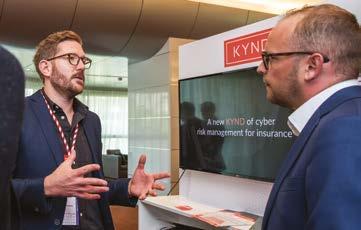

“International programmes can be very complex to arrange but Space B is inherently simple to use and manage,” he said.
“It gives us better control as we have an up-to-date view of the state of each policy. It is increasing the level of service to clients with automated notifications, and everything is transparent for every partner. It’s a different way of working that provides a more qualitative service for the client.”
Space B provides great oversight and control of a programme and encourages collaboration between parties and centralises all the key client information so it can be accessed by any party.
“It is increasingly becoming a necessity for tenders,” said David Horne of Bridge Insurance Brokers in the UK.
“Clients want to know how you are going to administrate the risk, not just place it. It gives us an opportunity to present ourselves as a joined up, collective network. The large global brokers will say that networks are never as joined up as they are, but we must prove that we are, and Space B will allow us to do that.”
In addition to meeting client expectations, Space B guarantees the quality and accuracy of the data being used as Hélène Paounov of French broker Filhet-Allard explained.
“It contains two really interesting features – compliance checks are integrated into the system, and it also hosts all the exposure information,” she said.
“Spreadsheets are a nightmare as too many people update the data and that leaves too much room for error but what we have delivers reliable and accurate data that is standardised at both ends.”
Ultimately, Space B is more than a program administration platform, as Pedro Moura Ferreira MDS pointed out to delegates.
“Clients want a view of their entire global insurance portfolio, and we can do this no matter where or what the exposures are as we have all the data online detailing everything that concerns the client’s business.
“It doesn’t matter if it is local or international as you can use it for local policies as well and it is a differentiator as nobody in the market is providing this to customers.”
Access to ever bigger tenders for Brokerslink affiliates allows everyone to grow and with Space B, access to that growth has never been easier.
The world of insurance is rapidly digitising to meet customer demands, improve the employee experience and increase efficiency. Every partner and affiliate within this network will be thinking about how they can digitise and meet changing demands which is why Brokerslink has been working hard to bring ever more digital capabilities to the network. The first six digital innovators have already joined us and form an exciting new arm of Brokerslink – B.tech.
Introducing the new affiliates who make up B.tech, Anne Collette of Brokerslink said: “Those who choose not to evolve in this space will almost certainly be left behind. To facilitate this transition, Brokerslink has expanded its network diversity through the integration of insurtech and technology firms.
“Following extensive market research to select key digital solutions, the new B.tech affiliates will provide our network with the tools to progress in areas such as user experience, operational efficiency, data interpretation and cyber security assessment, among others.”
The six new and exciting additions to the Brokerslink family are:
BWD

Specialists in technology for operational efficiency, they support organisations by automating and optimising business processes through their redesign and the application of RPA solutions, thereby reducing operational costs.
Innovagency
Innovagency is a full scope digital agency, helping its clients to think, design, build and activate digital platforms through the combination of strategy, UX/UI, technological and marketing skills.
Inovretail
Net Promotor Scores are an increasingly core element of any marketing strategy and Inovretail have developed an advanced NPS Survey that is now available to Brokerslink members.
IT Power
A claims management and business process management system that promises to give users more control, increased customer satisfaction and reduced claims processing time.
KYND
A cyber risk expert, KYND uses cyber-risk management tools to accelerate sales of cyber policies, speed up renewals and help control client risk while supporting better underwriting decisions by removing complexity and providing deeper risk insight.
Lightico
An award-winning SaaS platform helping businesses accelerate their customer journeys through automated workflows, collecting and connecting customer eSignatures, documents, payments and authenticate ID in real time.
The B.tech Hub
Brokerslink has always operated with an eye on the future and with the establishment of the B.tech affiliate group, that tradition continues today.
At this year’s conference, delegates were able to get up close and personal with the latest in insurance technology at the dedicated B.tech Hub. One of the most vibrant and energetic areas throughout the conference, the new B.tech affiliates were able to showcase their innovative new solutions to conference attendees.
Brightly lit and interactive, the Hub enabled both the new B.tech affiliates and a number of local InsurTech companies to show how their solutions could help enhance digitalisation within the network and bring greater technology-focused solutions to old and new challenges alike.
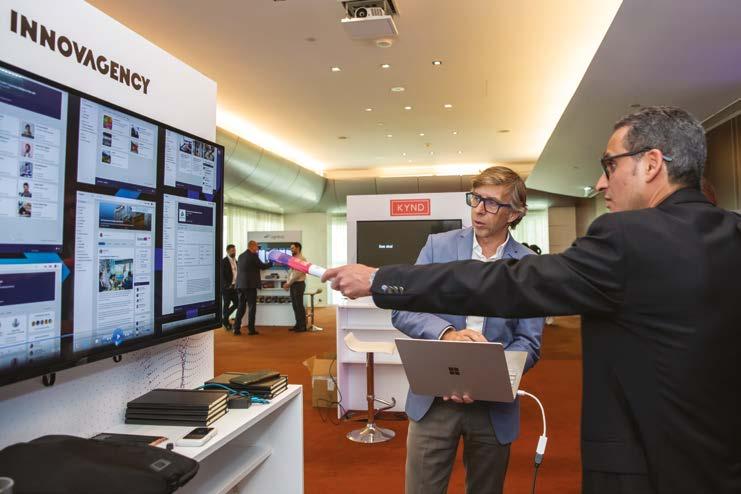
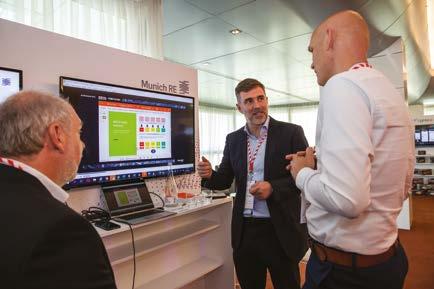
These new affiliates bring a huge range of digital capabilities to every member of the network – everything from automation and artificial intelligence to claims management systems and cyber solutions - and much more besides.
And while those who couldn’t be at the conference this year will not have experienced the vibrancy of the B.tech Hub in person, such is the nature of how these organisations operate, all the functionality they deliver and all the support they provide can be accessed remotely, wherever you are in the network or, indeed, the world. They’re waiting to see where they can take your business next …
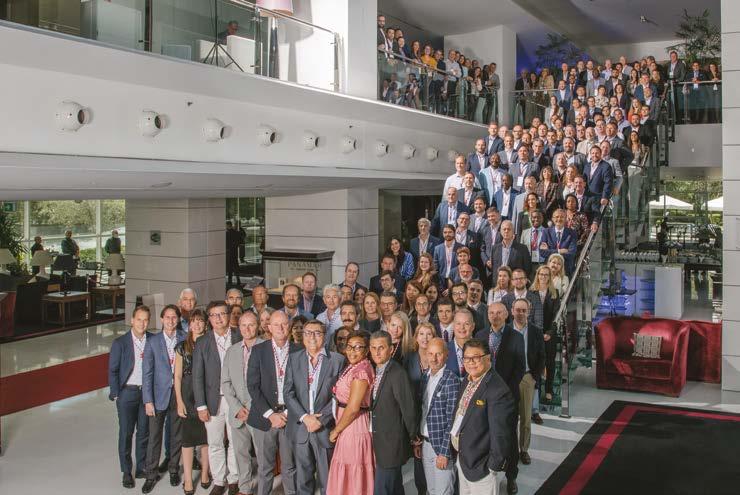
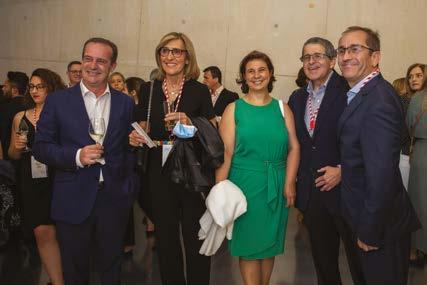


 Group photo
Conference participants at the Gala Dinner
Conference participants at the Networking Dinner
Musical moment at the Gala Dinner
Rogério Campos Henriques, CEO Fidelidade
Group photo
Conference participants at the Gala Dinner
Conference participants at the Networking Dinner
Musical moment at the Gala Dinner
Rogério Campos Henriques, CEO Fidelidade

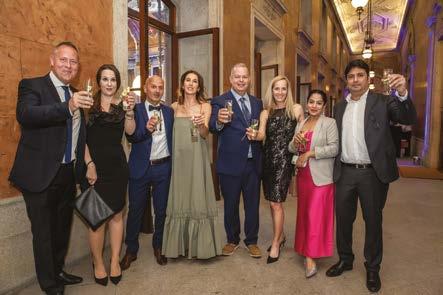

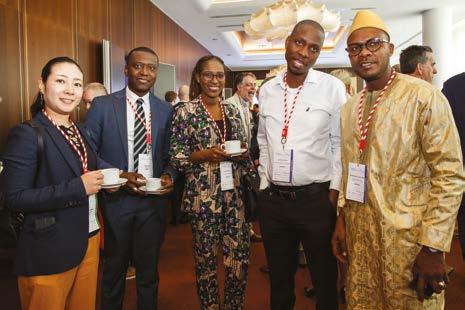
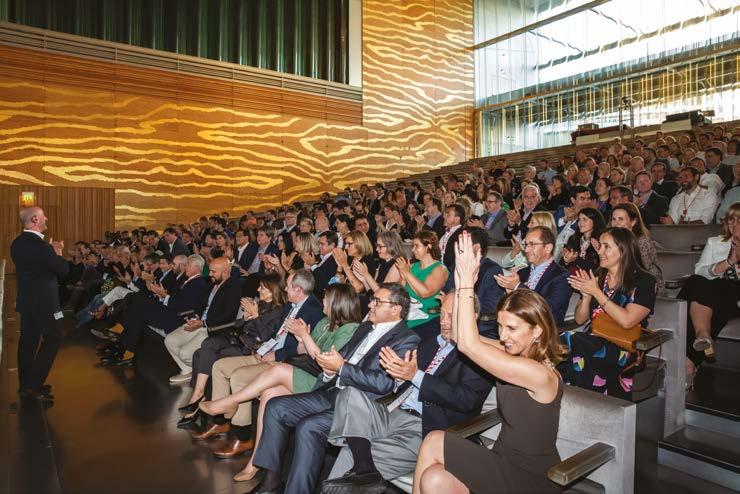


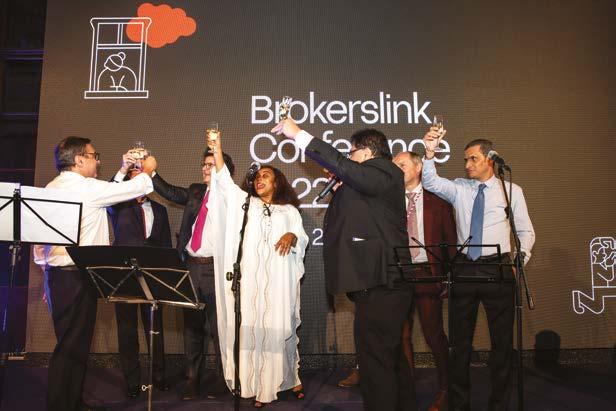
 Conference participants at the Networking Dinner
Conference participants Brokerslink Board members
Conference participants at the Gala Dinner
Conference participants at the Networking Dinner
Conference participants Brokerslink Board members
Conference participants at the Gala Dinner
Risk Managers’ Forum
The pandemic, the war in Ukraine, sanctions against Russia and widespread supply chain issues have focused minds in boardrooms across the globe and those boards have been turning to risk managers for a solution.
Amid all the chaos, the role of risk managers was elevated or as Manny Padilla, RIMS Board Member and MacAndrews & Forbes VP put it at this year’s Risk Managers’ Forum: “We were the adults in the room when everyone was losing their heads.”
Manny was joined at the fourth Risk Manager’s Forum by 30 fellow risk managers from around the world. The event was opened by special guest Dirk Wegener, President of FERMA, and kindly sponsored by Generali, the only insurer to be invited to the specialist event.
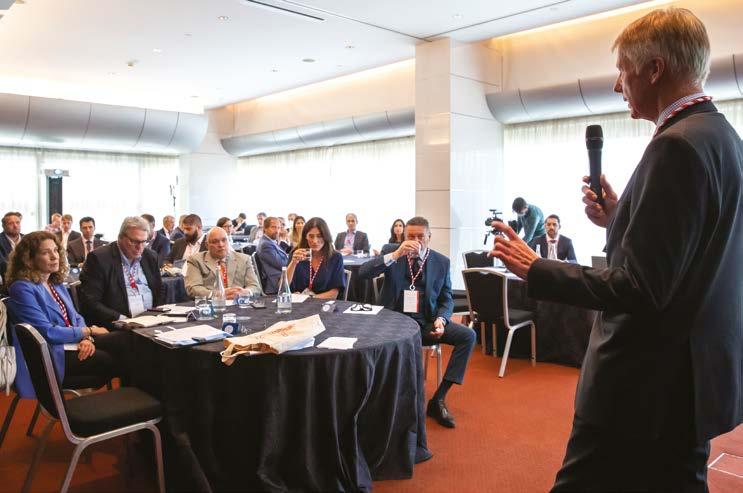
“There is no doubt that events of past two years have highlighted the importance of risk managers having a seat at the main table,” he said.
According to Dirk, the pandemic has increased the importance of the risk management function throughout organisations because risk managers were able to show their added value and it is now seen as a strategic function.
“Companies have an increased awareness of risks and exposures that have very heavy disruptive potential and there is now no natural boundary to the reach of risk management in a company. It is no longer limited to finance or compliance roles,” he said.
This new elevated position is to be welcomed after so many years of struggling to be heard, but with this new strategic importance come even greater expectations. There have been questions about risk managers didn’t have a pandemic or the war in Ukraine higher up the agenda.
There have been questions about why insurance policies didn’t provide business interruption (BI) cover during the pandemic. And, most challenging, there have been questions about whether risk management can manage the range of risks and the pace at which they are developing.
The consensus in the room was that these risks had indeed been on the radar, but they weren’t seen as a realistic threat in comparison to the more localised or historic issues that risk managers usually look at.
“We need to move from focusing on the standard things that might happen and start looking at what will not happen and then reverse engineer the response from there,” said Manny.
“As we look at the risk management issues of the future, we have to take a step back. Catastrophe modelling is important but is it as important as pandemic modelling? No. We are talking about calamities, rather than catastrophes and we need to start looking at things that seem like they can’t happen, suddenly being possible.”
Likewise, Maurizio Castelli, CEO of risk management firm Augustas, agreed that interest in risk management is much higher as today’s threats are verging on the existential, but there are challenges about why the pandemic or war in Ukraine wasn’t foreseen.
“They were on the map but maybe not ranked as high as they should have been,” he said.
“But if you have a good business continuity plan in place, you might not survive forever, but you can face these situations in a much better way. At least it makes a difference between surviving or disappearing in a few weeks or months.”
The idea that a global pandemic and a war causing international disruption could happen at virtually the same time,
was seen as simply too far-fetched for most risk managers, as Raphael Tasselli of Brazilian pulp and paper company Suzano, explained.
He said that in his company’s enterprise risk assessment, they have top risks they identify and none of them were war. It was something so far that nobody in the company had thought about because this kind of situation was considered something that would never happen.
“We need to think more about the global condition and less about inside our own production and operations. Pandemic and war were never there but we need to be the ones that provoke the business leaders and incentivise them to think creatively,” he said.
But the question remains, even if risk managers had identified the pandemic and war as active threats, would any of the policies that were in place have triggered? The refusal of insurers to pay out on BI claims across the globe during the pandemic suggests that we may be moving into a world where insurance is no longer seen as the answer to all risk problems.
“Even if we had cover that would trigger a BI claims during the pandemic, we would put all the insurance companies into bankruptcy in a couple of months,” said Manny. “The monthly exposures were $350bn which would make the insurance sector technically bankrupt.”
But the position insurers took appears to have damaged relations between the insurance industry and the sectors they seek to protect.
“There has been quite a lot of disappointment to the reaction of the industry to BI claims. And we remain concerned about the hard market and the reduced limits that insurers are issuing,” said Dirk.
“Most corporates are working under high-cost pressure as they struggle to overcome the financial losses from Covid.
FERMA hopes that our conference in Copenhagen this year will be an opportunity to restore this long-standing partnership between risk managers and the insurance industry.
He argued that insurance should be defending and protecting economies and societies from pandemics and other systemic risks as their ability to incentivise loss prevention activities is unique.
The sponsor of the event and the only insurer invited, Filippo Cinelli of Generali, sought to defend the insurance sector’s response to BI claims.
“We have to do a mea culpa on the way we treated Covid. Do we have modelling for this? Yes, but not for property damage, only for life,” he said.
He argued that the intention to cover property risks wasn’t there and therefore, policies were not priced for it.
“Reputationally speaking, having months of discussions is not good for the industry’s reputation but we are trying to create simplified wording in terms of pandemics and specifying what it means in terms of property damage,” he added.
The final, and perhaps most searching question being asked of risk managers, is whether their profession can keep up with the range of risks and the pace they are developing at? How can risk managers adapt their skills and experience to meet real challenges that had previously been seen as highly unlikely?
“The pace of risk is changing so fast that it is difficult for us to follow and keep up,” said Pedro Cupertino Miranda of Portuguese firm, Sonae MC.
“One way to achieve that is to give all the business managers the tools to assess the risk themselves instead of having a general global exercise. Give the tools to the management as they are used to responding quickly on competitive issues, and they can do the same thing with risk. It is too difficult to leave this only in the hands of risk managers.”
This approach requires a degree of internal collaboration, but that collaboration must reach outside of company walls and across sectors and professions. Because if risk managers and the insurance industry can’t find a way to tackle these emerging issues, there is a risk that clients will simply find alternative ways to manage their risk.
“Companies are starting to evaluate risk financing strategies alongside the usual risk management,” said Javier Mirabal of MRM.
“They are trying to understand how they can use financial instruments for where insurance doesn’t provide cover.They are looking for alternative finance support because risk transfer is not enough as the landscape is completely different. They have to do something.”
As do risk managers if they are going to secure their newfound prominence at board level. The last two years have highlighted the strategic importance of managing risk, but those questions remain – are risk managers and insurers still the answer?
“The solution to one problem generates more problems. Our profession deals with the risk, and we can put a big part of that with insurance companies, but a lot of our risks aren’t insurable,” said Jorge Luzzi, host of the Forum and Chairman of APOGERIS, the Portuguese risk management association.
Exploring this theme, Jorge turned to Cláudia Silva from Super Bock, the Portuguese beer company, to ask how she was managing the impact the war and pandemic have had on logistics and the supply chain.
“We have transportation problems as we normally export containers twice a month but now, we can only do that once a month,” she said.
“But it’s not just about transportation – it’s about the raw materials for the beer too. We increased production because tourism is increasing in Portugal again and our sales are increasing, but we have problems with raw materials and transportation.”
She explained that they have managed this by turning to more local suppliers for the necessary raw materials, but this has led to an increase in cost.
Jorge Leitão of HighDome has experienced similar problems: “We don’t have exposure to Russia directly, but we do indirectly. We sell products that are produced around the world, and we are now buying through alternative producers, but the price is higher so we are contributing indirectly to rising inflation.
We don’t want to do it, but we have to. It’s a problem inside of a problem inside of a problem.”
And he added that as companies scour the globe to find alternative sources for materials, their carbon footprint will increase markedly.
“That has a huge impact on your ESG rating,” he said.
If risk managers have to evolve to meet these new challenges, so too do insurers. In line with one of the recurring themes throughout the conference, the answer to these problems lies in a willingness for all parties to work together to find joint solutions to mutual problems.
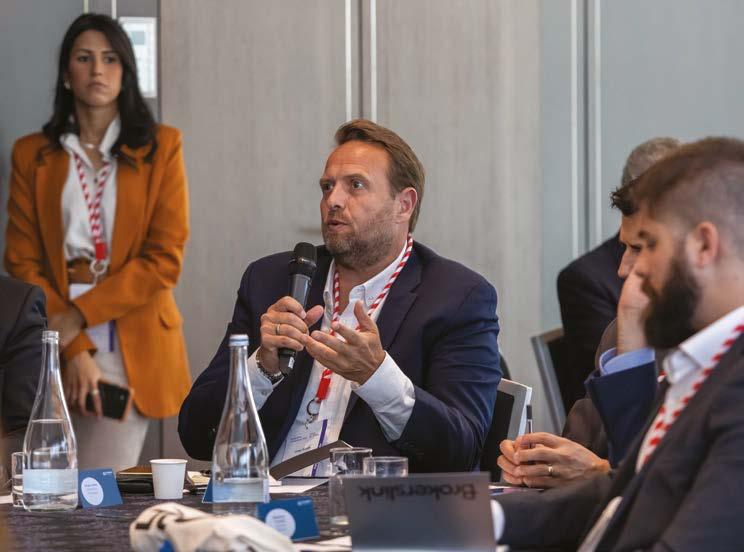
Generali have already started that process with the introduction of a parametric approach to insurance.
“This is not something new as it has existed for 15 years, but the big change is the data that is available today – there is more of it and it is of a higher quality,” said Filippo.
A parametric insurance policy agrees to make a payment based on the occurrence of a pre-determined event, for example, a windstorm. Parametric insurance costs less, indemnity is agreed in a matter of days, it is very transparent, and it is tailored to the risk.
“It is another tool to mitigate risks and complete your insurance programme as you are covering financial loss, property damage, BI, extra expenses and non-damage BI,” he argued.
In whatever way insurers and risk managers approach these new systemic risks, be that with ingenuity or technology, success will require a collaborative approach. Nobody expected what the last two to three years have thrown at us. To apportion blame for that, we can point to the insurance companies. We can point to the risk managers. Or we can even point to the clients themselves.
But the reality is that these are new and poorly understood risks and the only way they are going to be managed successfully, is through collaboration and partnership, exactly what Dirk hopes to achieve at FERMA’s upcoming conference in Copenhagen.
“There is a greater need for risk managers to collaborate with each other and other functions,” said Dirk.

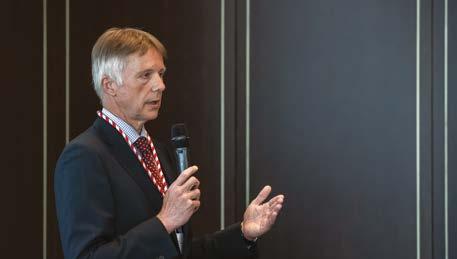
“We will be able to provide the enterprise perspective that executives and decision makers need, but we are in the middle of an evolution and those core risk management activities of risk identification, analysis and treatment will increase in importance.
“Risk management can go further and a key lesson from the pandemic was that measures that are sufficiently flexible can create resilience, even to catastrophic and systemic risks.”
Welcome from the Mayor 4.1
The second day of the conference is traditionally the day when external guests and supporters of the network are invited to share their perspectives of the world and the role insurance has to play in it. And as a very special guest, the day was opened by the Mayor of Porto, Rui Moreira.

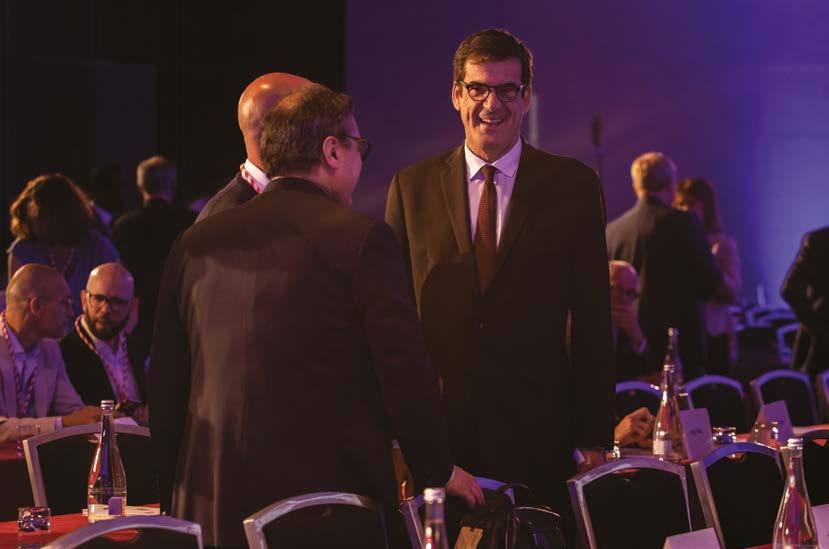
He highlighted how important it was for Porto to host events such as the Brokerslink Conference, particularly after a tough two years during the pandemic. And coming from a fading, industrial past, he said that even before the pandemic, Porto had to rethink the kind of city it wanted to be, just as Brokerslink was redefining its own purpose.
“We are a small city, and we don’t want to be a big city,” he said.
“We wanted a city that would be interesting and comfortable for children and families. How do we make the change, how do we attract business and ensure that people want to live here?”
That was the challenge facing the city and he explained to delegates that cities around Europe have had to go through a similar process to react to the changing demands made of them.
“It wasn’t about providing tax benefits. It was about focusing on lifestyle and promoting talent.We have young people who until a few years ago had to leave the country for jobs but now we have been able to keep the talent and are attracting more from elsewhere,” he said.
Ultimately, they built a city tailored to its existing inhabitants and the ones they wanted to attract. And as the city of Porto has reacted to the changing society and world around it, so too must the insurance industry react to ensure that it remains relevant and attractive to changing client demands.
Partnering for progress
A tech revolution is coming 4.3
With all this pressure and uncertainty, clients, and particularly large corporates, are looking to commercial insurers and their brokers to get back in control of their risks, to understand their exposures and how they change because of increasingly extreme scenarios.
Martin Thormählen
CTO, MUNICH RE(Re)insurance companies don’t come much bigger than Swiss Re, a company that has been a great partner to Brokerslink. When that company speaks, the market tends to sit up and take notice, so it was a huge privilege to once again have Andreas Berger, the CEO of Swiss Re Corporate Solutions, the commercial insurance arm of the Swiss Re Group, address delegates at the conference.
His message was clear – digital platforms, which offer huge potential to reduce complexity and enhanced risk insight, are now the most important tool that any broker can have. And the good news for Brokerslink partners and affiliates is that they already have that tool in the shape of Space B for handling multinational programmes.
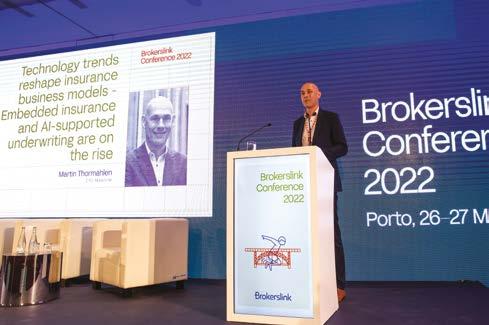
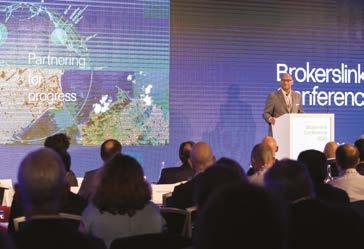
“If you look at the commercial insurers’ Q1 results, everyone appears to be doing well. But if you look at global risks, such as climate change, inflation, geopolitical uncertainty and war, you have to ask whether all of this has been factored into the reserves and the pricing,” he said.
He expressed the view that it had been partially factored in, but that inflation was a much bigger issue than had been expected, and worse, it shows no signs of easing off.
“As a result of the horrific and ongoing war in Ukraine, we have more inflation coming. A number of leading banks are predicting that inflation will increase to double digits in some economies next year. Short term lines such as property and motor will be impacted by inflation immediately,” he said adding that one car manufacturer told him spare parts now cost 1,000% more, a cost that cannot be passed on to clients.
“Many CEOs and corporate risk professionals say they want to gain more transparency on the risks lurking in their global, multi-tier supply chain networks. Presently this is not possible because the risk data that is provided to the broker is incomplete and often gives an historic view. The underwriter then tries to put that data into their models, which doesn’t give you a real picture of the risk. So, insurers issue the cover, shake hands and everything is fine. But we know the policy doesn’t reflect reality and the real exposure,” he said.
He then dared delegates to imagine the world differently, one where the customer has all their data in one place, can access it through a digital platform and can, with the support of their broker, start to understand their true risk profile.
“What if you could control your data, bring it together from across your business to create a digital twin of your assets and properties? Then invite experts to enrich the data to see what simulated loss events could cause disruptions and vulnerabilities. This would then provide actionable insights that could be fed back into the organisation to help manage risk and build resilience,” he explained.
“And that is precisely what Space B allows all of you to do and I would like to invite you on this journey with us,” he said.
Increasingly, it is those brokers that have access to data, can model it, make sense of it for their clients and help them regain control of their risk, that are going to win out. And with Space B, Brokerslink partners and affiliates already have a head start over their rivals.
Space B enables Brokerslink partners and affiliates to better organise and administer their multinational programmes, providing a clear view to customers. Having captured and structured the customer’s data it can then be used so much more extensively, to support the overall risk management strategies.
If we thought the rapid digitisation of all aspects of insurance during the pandemic was something to behold, we haven’t seen anything yet according to Munich Re’s Chief Technology Officer (CTO), Martin Thormählen.
As the CTO of one of the world’s largest insurance firms, it’s safe to say that he is on top of both current and future digital trends, and he had a warning for delegates: “Quantum computing and the Metaverse are set to take the insurance industry by storm.”
While he explained that quantum computers were not yet stable enough for widespread application, the big tech firms are investing heavily to make the tech available – so it’s coming. And it was a similar message about the Metaverse. It may currently be confined largely to the virtual worlds and gaming, but Martin revealed that companies are already experimenting with it.
“BMW is creating ‘digital twins’ of complex environments where the construction of factories can be fully simulated and planning times optimised significantly. Also, JP Morgan has opened a virtual launch which you can visit and explore their services” he said, pointing out that this is something that every insurer and broker could work towards providing.
He predicted that the Metaverse would become crucial for client-facing services as geography becomes increasingly meaningless: “This will start to replace tools like Zoom and Teams, not just for client relationships but for internal collaboration and training.”
The development of technology is allowing everyone to rethink how they operate and what new opportunities they can explore and for some, that means selling insurance embedded.
“It’s on the rise and while it is standard in China already, multi-national car manufacturers, retailers, and eCommerce companies are building seamless buy-journeys today. The embedded insurance distribution model is growing fast, new players aim for a share of the commissions” he warned.
“If brokers and insurers want to be active here, they have to understand that the new distribution partners will want to have their own way of integrating. Having best in class integration capabilities is vital if we are to integrate quickly and cheaply to win these partners over.”
Understanding and leveraging your DE&I ecosystem for greater impact
Profitable caring 4.5
Steven Braekeveldt CEO, AGEAS PORTUGALWhen it comes to diversity, few organisations are as naturally diverse as Brokerslink. One look around the conference room would have told you that. But as Miguel Miranda, Regional Underwriter at AIG explained, achieving true diversity, equity and inclusion (DE&I) in a business means more than just looking different.
“Diversity and inclusion are major concerns for every business although there is a huge focus on gender at the expense of every other dimension,” said Miguel.
“Gender is the obvious one, but we need to be considering all the others like gender expression, age, ethnicity, physical ability, sexual orientation, personality and behaviours amongst others. More than that, they need to look at the equitable treatment of all employees to ensure that they feel valued.”
The prize for getting DE&I right in an organisation is big and well established. Miguel shared some statistics that showed truly diverse organisations are between 25-36% more likely to outperform peers on profitability, have a 30% greater ability to spot and reduce business risks and have an up to 20% higher rate of innovation.
But to secure those prizes, organisations (including the partners and affiliates of Brokerslink) have to go beyond seeing this as discrete exercise to be completed and view it much more as a strategic imperative, one that they have to truly believe in if they have any hopes of it delivering.
“Diverse perspectives foster diverse thinking and help businesses address challenges in different ways,” he said, “while equitable treatment of others makes the entire workforce feel
valued and having inclusive policies in place ensures that resources are distributed to those that need them most.”
Less a tick box exercise and more a genuine cultural transformation, securing the benefits of a diverse organisation requires belief and action from the top on a consistent basis. This isn’t an issue that can be delegated – it is a strategic goal and as such, is the responsibility for everyone to deliver, from the CEO down to the newest recruit.
“People need to feel integrated, not just part of a programme of change,” he advised.
“If you really don’t feel it and make it happen every day, all your efforts will wash away in a couple of years. But the people you are trying to recruit won’t have changed and they are your most valuable asset.”
He said that there is a lot of work to do to get it right within individual organisations but fundamentally, success is dependent upon whether the business’ leaders truly believe in DE&I. Those that do and implement with skill will thrive. Those that don’t, will eventually wither and die.
And while the challenge is huge, the response is manageable.
“Everyone can make the necessary change. It doesn’t need to be a huge programme. You can start small because there are lots of small changes we can all start making. But just start and start now. That is the most important thing,” he said.
For most, the number one imperative of business is to make a profit and when that has been achieved, the goal is to keep increasing that profit. A fundamental factor of capitalism, year on year growth is the name of the game.
That has been the motivation for businesspeople since time immemorial but as Steven Braekeveldt, CEO of Ageas in Portugal and the CEO of Ageas, Continental Europe explained, times have changed, and the insurance industry must also change to meet the challenge.
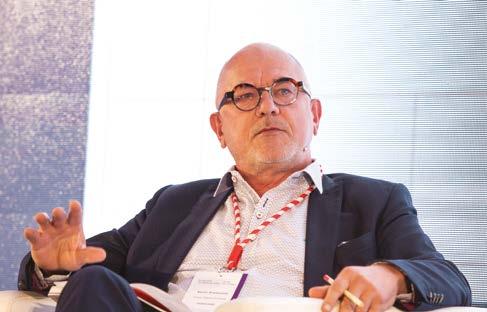
“Sustainability will become one of your major agenda points in the future,” he said.
“I predict that 90% of people in this room today still have KPIs based on growth. More growth, more top line, more profit. That’s not unusual of course but it’s very strange that when we know the earth can’t cope with continual growth, we still work towards that with our old fashioned KPIs.
“There is nothing wrong with making more profit. It’s how you make it that’s important, so your financial KPIs should be in synch with your sustainability goals. In fact, your KPIs should arise from your sustainability goals.”
He said the insurance sector needed to undergo a huge shift in its mentality if it was to meet the challenges that businesses face today.
“There needs to be a huge mentality shift because customers will not look at how much profit you make but how you make that profit. That’s the important thing and you will be taxed in accordance with how you make those profits. That’s not conjecture, that’s coming,” he warned.
There is a view that sustainability and profits are two different things, but Steven believes otherwise: “They’re not. If companies can marry the two, they have the potential to have a very long existence and I am convinced about this.”
But more than that, he said companies really must start understanding the impact their continual growth has on society.

“We have to ask ourselves what we are doing to the planet with our continual growth and what that will do to long-term profits but more importantly, what that will do to people?” he asked.
“There are studies showing that your growth puts the environment and other people in poverty. So, the question is, what is the ethical way to do business? Who carries the ethical responsibility for that social impact? It’s fascinating.”
While acknowledging that these are huge challenges for any business to face, Steven insisted that insurance has a crucial role to play, not just in its own adaptation, but in helping its clients make the same transition.
“We need to build an emotional link with our customers and engage with them on a human level,” he said.
“As an insurer, we need to be extreme in prevention. We don’t want people to be sick or to die or for businesses to go bust. An insurer should prevent the client getting ill. That is our role but it’s a very difficult mindset to change.”
Ultimately, he said that if insurance wants to make the shift from profit at all costs to profit that comes from sustainability, then it must regain an emotional connection with clients.
“Insurance is about insuring what you love – your children, your grandparents, your family, your house, your business … everything that has an emotional link to you,” he said.
“We need to adapt to be more emotional. Once you are engaging on an emotional level with clients, then you get emotion back to insurance.They will feel that you really care about them.”
Tellingly, he said that technology, in particular AI and robotics, could help insurance re-establish that emotional link. But more than anything, the industry must lose its growth at all costs mantra and replace it with growth only from sustainable practices.
And in a provocative but entirely appropriate closing, he told delegates: “There is only one organism that has growth as an imperative, and that is cancer. Going for growth for growth’s sake is old fashioned, in fact, its mediaeval. Those companies that do this are simply destroying the world faster and they need to find a better, more sustainable way.”
5.1
Seven grand effects of global powers competition
With everything happening in the world today – from a pandemic and war in Ukraine to the climate crisis and growing social unrest – it can be hard for business leaders to keep up, never mind understand its impact.
In times of uncertainty, business tends to turn to insurance for an answer, but such is the scale and complexity of the emerging global risks, that even insurance is being challenged to come up with an appropriate response. But there is one man whose job is to track and map out these risks and Bernardo Pires de Lima, a recognised expert in foreign affairs and advisor to the President of Portugal, shared his expertise with Brokerslink.
Bernardo has identified seven key, global trends:
• War as a tool for strategic disputes
• Cyber warfare as another level of external intervention
• The clash between democracies and autocracies
• Sanctions as part of a decoupling process between industrial economies
• Existential threat to multinational organisations
• Long-term disruption to trade, supply chains, energy and food security
• Natural resource extraction for a technological race
“War is being used as a tool for strategic disputes. The use of force hasn’t been absent from international politics, but now great powers are showing the will to confront using military capability,” he said.
He added that cyber warfare – against commercial enterprises and democratic systems – was a growing threat that required not just regulation but collaboration with the big tech firms while the clash of democracies and autocracies was changing the dynamic of the world and the global economy: “For the first time in the 20th century, fewer than half the world lives in a democracy, and that will likely result in less engagement between nations.”
Bernardo sees this lack of engagement manifesting itself in many ways, particularly in the use of sanctions against Russia and in the growing threat to multilateral organisations, notably the attacks made on the World Health Organisation during the pandemic.
The final two trends focus on trade and resources with Bernardo pointing out that the disruption to trade, supply chains, energy and food security is likely to continue until lockdowns stop and the Ukraine situation finds a permanent settlement.
And finally, he said there is a dash to secure natural resources, particularly minerals, to fuel the technological race, giving great advantages to the likes of China, the US, Australia, Chile and Indonesia but also presenting a huge environmental challenge.
After outlining these key trends, Bernardo was joined by Grant English, a Political Violence and Terrorism Underwriter at Geo Underwriting and Duncan Strachan, a Partner at legal firm, DAC Beachcroft.
“Companies and consumers are sufficiently flexible to adapt to circumstances, but they prefer predictability. Adaptation is at the core of the business sector but permanent conflict and belligerent narratives among politicians and parties, are dangerous,” said Bernardo starting the discussion.
However, he said this creates new opportunities if some of the clashes in the system can be anticipated, and ways to mitigate them found.
“What is happening now is a product of policy from various US regimes over the last 20 years,” Duncan pointed out.
“China was becoming a dominant power in the world and the US felt there had to be a decoupling process to not lose control. In the meantime, business has carried on and the insurance industry is an example of the success of that.
“I can’t see the international business that is done with brokers and insurers all over the world stopping, but the conversations between businesses and insurers needs to change from asking what the financial risks are to what the geopolitical risks are.”
He added that it was important for brokers to map out all the risks Bernardo had highlighted and focus on how they can help clients protect against the unthinkable – a break-up of the EU, a nuclear attack or huge losses in space.
“We haven’t yet found the way to engage with China and it’s the same with Russia,” said Bernardo.
“We don’t influence the internal process in China, so we are completely influenced by their dynamics – lockdowns and their relations with Southeast Asian countries, for example.”
Grant again raised the point of long-standing US policy towards China as one of the key elements in the mix: “Throughout the late 90s, the US was in pole position and started outsourcing a lot of their manufacturing to the east and that contributed to the rise of China.”
Turning to the role of technology, there was a suggestion that social media, with all its influence and ability to connect people, could be part of the solution to some of these problems, but the panellists weren’t convinced.

“I don’t think social media can be a peacemaker,” said Grant. “But they have to be recognised as bringing something valuable – they are a superpower in themselves.”
Likewise, Bernardo was not convinced: “I would be happy if they complied with their own fiscal responsibilities. That would be a huge step. But as peacemakers, we need to rely on organisations and the wisdom of political leaders, not on big tech.”
Bringing the session to an end, Bernardo advised delegates to start looking out for these trends and help their clients manage them: “I want to ask every CEO and board member in the room today, analyse the political and social trends and geopolitical risks that are out there in order to better prepare your clients for the future.”
Aviation - the phoenix from the flames
Chad PRESIDENT, PIIQ RISK PARTNERS Hue Williams SENIOR PARTNER, PIIQ RISK PARTNERS5.3
Risk managing a global supply chain
Laurent Freixe EXECUTIVE VICE PRESIDENT & CEO LATIN AMERICA, NESTLÉOf all businesses, few suffered through the pandemic as much as the aviation sector did. According to the International Air Transport Association, the sector lost $200bn, 17,000 aircraft were grounded and at least one airline in the Asia Pacific region experienced a 98% drop in passenger traffic.
In short, the pandemic saw the floor fall out of the sector but as Marcel Chad and Mark Hue Williams of Piiq Insurance explained to delegates, it is a resilient industry and one that is ready to bounce back with the right support
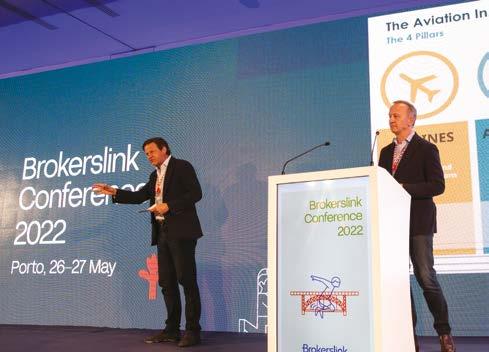
“It’s an exciting market with huge opportunities for everyone in this room because the supply chain is massive,” said Marcel.
He outlined the four pillars of aviation – airlines, aerospace, general aviation and space and satellites – and stressed that opportunities lay in each one for enterprising brokers.
“It’s a very diverse industry with airlines requiring airports, air traffic control, hangars, maintenance and control and there are so many different types of aviation, from commercial and industrial to business jets and even gliders and balloons,” said Marcel.
Despite its recent experience, Marcel said the industry was already bouncing back: “It is very resilient, and flights are now full, fares are high to survive, and new start-up airlines are emerging –six new airlines around the world have approached us.”
However, recovery from the pandemic is not the only concern facing the sector – the global pressures affecting every business are biting particularly hard.
“There is a global pilot shortage which is driving increased salary costs for flight crews as airlines compete to fill their
cockpits and while passenger numbers are approaching preCovid levels, that is not the case in Asia. Also, airlines must deal with crude oil volatility as they spend to the tune of 40% of their revenue on fuel and capital markets have been affected by the war in Ukraine which impacts airline financing,” said Mark.
Beyond this, the aviation sector is very high profile – when something happens, it is often front-page news. And factoring in a commitment to being carbon neutral by 2050, the challenges facing aviation are significant but as Marcel stressed, not insurmountable.
“This industry is changing rapidly every single day and we are keeping pace. But how can we make ourselves relevant beyond the mandatory insurance? If we challenge and inspire ourselves as an industry the lines between finance, risk and insurance will blend,” said Marcel.
And he appealed to delegates to help Piiq in its mission to support the aviation sector as, he believes, the nature of the Brokerslink network is ideally suited to provide the support the sector seeks.
“We are going through a process of deglobalisation which is a huge opportunity for on the ground, local, connected expertises which plays really well into the Brokerslink model,” he said.
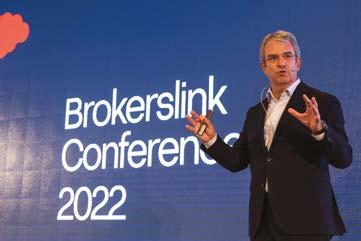
“We can bring the industry knowledge and advice if you bring your expertise around the lines and sectors that feed into the aviation industry. And importantly, there doesn’t have to be a transaction at the end – the opportunity to consult and advise is just as valuable.”
Supply chains and how to manage them in the face of mounting, global risks, was a constant theme throughout the conference and one that is taxing the minds of organisations across the world.
And one company that needs to focus on supply chains more than most is Nestlé, the world’s largest food and beverage company. And sharing the experience of risk managing one of the most extensive and complex supply chains in business was Laurent Freixe, Executive Vice President at Nestlé.
Nestlé’s business is all about supply chains. With more than 2000 brands in 187 countries, regular and reliable access to raw materials is an operational imperative, an imperative that was tested to the limits during the pandemic.
“We felt all the consequences of the pandemic. The dislocation of the global supply chain has been a big consequence and is far from being resolved,” Laurent revealed.
“The supply chain crisis can be defined as a supply or a demand crisis. In fact, it is both. We work with six million farmers around the world, have 100,000 suppliers and buy $55bn worth of raw materials every year. It is a huge global market and despite being the largest consumer and food and beverage company in the world, we only account for 3% of the packaged food market.”
That means the fight to keep supply chains operational is intensified as competitors each seek to secure access to the same raw materials and supplies. But beyond supply chains, Nestlé has a major sustainability challenge to meet.
“The global emissions of Nestlé are larger than the emissions of the Swiss federation, in fact twice as large. That is the magnitude of the challenge ahead of us,” he said.
“The crisis is multi-dimensional, and sustainability is becoming a business imperative. A commitment to zero net emissions by 2050 doesn’t mean we have 28 years to start acting. We need to reduce our emissions by 20% by 2025 and by 50% by 2030.”
All of this has caused something of a rethink within Nestlé about how they map out and react to the challenges threatening the business. Laurent explained that normally, they would take the tried and tested enterprise risk management approach, one that has kept the company safe to date. But such is the nature of risk today, they have had to take a different approach.
“We need to map these new risks, be clearer on our appetite for them and define the proper actions to move forward,” he said.
The plans need to be simple, concrete and actionable to meet the challenge adequately. But more than that, the risk management solutions and the business operations must be flexible enough to respond and adapt to whatever comes next.
For Nestlé, that means optimising the end-to-end value chain, increasing the diversity of suppliers, creating flexible product recipes, and increasing localised production. This approach, Laurent believes, will make the business more resilient but for wider society to absorb these risks, greater levels of cooperation are required.
“All the issues the world is facing are of a global and complex nature. Nobody can solve those problems alone, so the answer must be collective and collaborative,” he said.
Geography is everything
Marshall JOURNALIST, WRITER AND BROADCASTERThe traditional way to spot and mitigate emerging risks, is to look at the political and economic landscape in which you are operating and map out where disruption to operations could emerge.
But there is another way and that is to consider geography. Tim Marshall is a journalist and author specialising in geopolitics and he believes that by looking at the geography of nations, we can predict their actions more accurately.
“If I want to understand a conflict or a country, I start with the geography. Only once I understand that do read up on the history and politics,” he told delegates.
“That approach allows you to make a reasonable forecast of the possibilities of what will happen next, and I encourage you all to follow that approach.”
He explained that during the cold war (1945-89), we existed in a bipolar political world with the US and Russia being the only two major powers. After the fall of communism, the US reigned supreme until 2008 when Tim says we entered a multipolar world, a world that exists to this day.
“By the end of this decade, that will have come to an end when we will return to a bipolar situation between the US and China,” predicted Tim.
In a wide ranging and fascinating talk, Tim covered everything from the rise and fall of the British Empire to how mineral deposits on earth and in space will dictate how world powers will behave in the future. But his main focus was on Russia and China and how we can explain their recent actions … and predict their future ones.
He believes that Russia’s invasion of the Ukraine can be explained first by its geography and second by its history. Russia has limited access to open ports in the winter and there is a vast 300-mile-wide plain that stretches to the west of the country, a plain that we recognise as Poland. History shows that Russia has been invaded roughly every 35 years in the last 400 and it was through that flat plain that invaders have always come.
“Naturally, you want to plug that gap but when Poland joined the European family, Russia lost that plug,” he explained.
“They are not going to risk the same with Ukraine [and its ports] and in 2014, it looked like Ukraine wanted to join the European family of democracies. Putin can’t have that so invades the Donbas region to create a mini buffer zone and then annexes Crimea because that is where the Black Sea port is.”
After the annexation, things settled for a while but by 2022, in Putin’s mind it was time to push on again. The reason? America’s botched withdrawal from Afghanistan presented both Russia and China with an opportunity to test America’s resolve. Russia moved first.
“This has been a watershed moment, easily as big as 2001 and we will see the ramifications of it play out over the next 20 years. Even when the Ukraine situation settles one way or another, it’s not the end of it,” Tim warned.
From there, he pivoted towards China, the other nation keeping democracies awake at night.
“When the Chinese look out to sea, there is a barrier made up of American-friendly nations which makes them feel hemmed in, just as the Russians feel hemmed in by not having access to the sea,” he said.
This explains China’s attitude in the South China Sea where it claims most of it as its territorial water. Which creates a problem as countries are only supposed to claim 200km of sea but China claims all of it and is actively building islands of concrete in the sea and claiming sovereignty over them.
Tim predicts that at some point in the middle of this century, China will try to enforce its view but on Taiwan, he thinks the Chinese will be more cautious.
“I don’t think they’ll do it this decade. It’s a 120-mile sea crossing in rough waters and you need at least 500,000 soldiers. But America can bring its aircraft carriers, as can the British, the French and Japanese,” he said.
“That military force is far more powerful than the Chinese military and the Chinese don’t know for sure if those countries will come and support Taiwan. And there are only five beaches in Taiwan that can be landed on, so Taiwan knows exactly where the Chinese are going to come from.”
Having seen the Russian experience in Ukraine, Tim is guessing that China doesn’t want to risk everything for the sake of Taiwan: “If they lose, that could be the end of the communist party. I hope I’m right, but it’s a guess.”
And he pointed out that these global tensions are not limited to the terrestrial world – space, it seems, really is the final frontier when it comes to geopolitics.
“Think of space in geographic terms,” he said.
“It has regions that you want to be in control of and others you don’t necessarily care about. Low earth orbit is where the satellites are and countries will want to be in control of that area as it contains so many of the operating systems that run life on earth.”
Cyber warfare is growing, and satellites are increasingly likely to become a target with the Russians having already built a satellite that can kill other satellites and, Tim predicts, other countries will follow suit: “War in space isn’t science fiction – it’s now.”
While there are threats, space also offers a huge commercial opportunity to the insurance industry and not just regarding cyber risks. Countries and companies are actively exploring how they can access and mine the minerals contained in asteroids and just as on earth, those explorers will need the kind of support that only the insurance industry can provide.
Despite this complex view of the world, Tim said that he was a natural optimist and as such, is optimistic about the economy, our collective future and about human beings.
“We already have space craft the size of a thumbnail.We can 3D print in space. We have designed spaceships that use lasers for propulsion. The German astronomer Kepler knew 400 years ago we would do something like that and there are people, particularly in the younger generation, who want to solve our problems and ultimately, that is why I am optimistic,” he said, closing the conference.
In closing, José Manuel Fonseca took to the stage one more time to thank everyone for attending, for their efforts, their engagement and for their ambition.

As Brokerslink’s ambitions continue to grow and expand across the globe and into new product lines, the Brokerslink Conference 2023 promises to be another great opportunity to understand what is happening in the wider world, how we can predict and react to the threats and how we can all find even better ways to protect our clients.
And for next year, José revealed that everyone is invited to São Paulo, the largest city in South America, one of the world’s most populous cities and the financial and industrial heartland of the Brazilian economy.
With the world’s 7th largest economy and 7th largest consumer market, it is certainly a city where business is done but it is also an incredibly vibrant and varied city that prides itself on a culture that has created some of the finest dining, shopping, and entertainment experiences in the world.
It has been another fantastic conference and none of it could have been possible without all of you. Thank you and here’s to São Paulo!
Social Programme
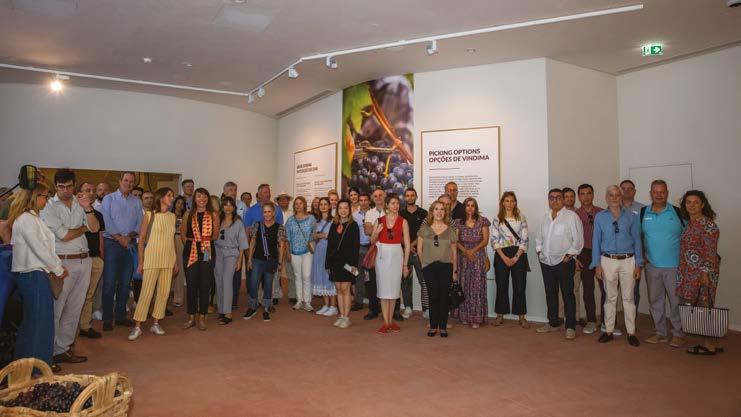
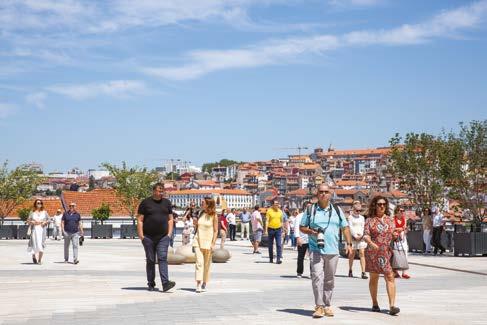



@ World of Wine
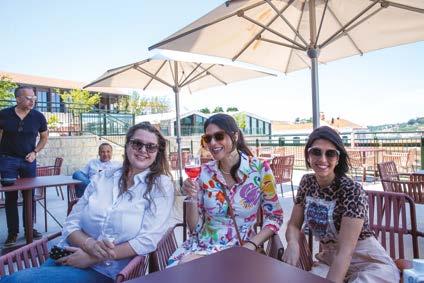
Social Programme
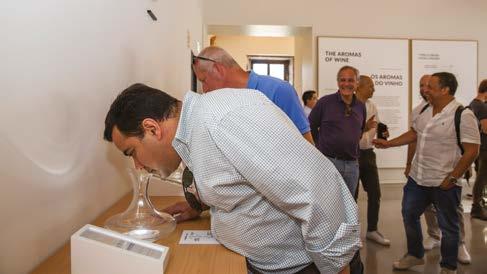
@ World of Wine

